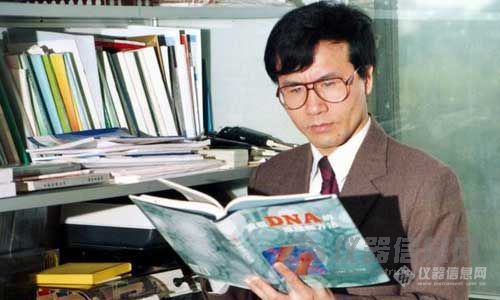


智慧的弟弟
第1楼2008/06/18
邓子新院士近期主要研究课题
(1) 一种新的DNA硫化修饰系统 已知DNA是由C,H,O,N,P五种元素所构成的, 我室在作为生命中枢的DNA大分子上发现了某些微生物基因组中硫(S)的存在, 而且分离出与硫修饰有关的完整基因簇。这项发现为从遗传学、生化学和化学领域协作攻关并从根本上揭示DNA硫修饰的本质提供了新思路。DNA新结构的最终阐明将丰富分子生物学的基础理论,打开一个新的学科领域,也将为DNA损伤,甚至癌症治疗因子的作用机理提供理论基础。如同甲基化的修饰(以前已知的唯一DNA修饰)导致了一系列新的发现一样,DNA上硫化修饰的发现也可预期产生分子生物学领域新的“信息”流。目前,已拥有硫化修饰基因(簇)和一系列突变株, 奠定了进行体外基因表达,研究酶学功能的条件, 也为最终从分子水平上阐明修饰的化学本质和生物学意义奠定了良好的基础。
(2) 重要微生物基因(簇)分离与克隆 基因资源是生命科学领域竞争白热化的一个焦点领域,也是未来重量级微生物新知识产权形成的基础。我室正加强对我国微生物基因(簇)资源,而不仅仅是菌种资源的重视。在已分离鉴定的许多重要微生物基因的基础上,在近年内将形成我国新知识产权的微生物基因(簇)包括:杀虫性大环内酯抗生素梅岭霉素基因簇和多醚类抗生素南昌霉素基因簇,抗病性氨基糖苷类抗生素井岗霉素基因簇,抗真菌多烯大环内酯类抗生素杀念菌素基因簇,具有重要价值的微生物酶类的基因将包括磷酯酶A2,胆固醇氧化酶,琼脂酶,脂肪酶基因及其一系列杀虫抗病微生物农药产品的正、负调节(途径专一性或全局性)基因等。许多类别的基因将构成我国首创和独有的知识产权,预期会对农业、医药、卫生、环境等领域高新技术产业的形成与发展作出贡献。
(3) 微生物代谢工程与化学生物学 随着分子生物学的发展及其向微生物农、医药研究领域的渗透,微生物药物的生物合成正面临着又一次革命性的变化,即由基因工程发展到代谢工程的变化,也就是用基因工程手段来重新设计代谢系统。我室顺应这种变化,为近年内在此领域取得突破奠定了较好的物质和技术基础,获得了大量与生物合成相关的基因并阐明了一些重要基因的结构、功能及其表达、调控之机理,发展了一系列体内外的分子操作技术。尤其是是克隆了国际上首例多烯类、聚醚类两个抗生素基因簇并阐明了多烯、聚醚类抗生素基因簇的结构特征。已经分离的多烯、聚醚、氨基糖苷抗生素基因簇及其一系列与抗生素生物合成、代谢调控有关的因子的分离已经构成我国特有的知识产权,并用来提高现有一些药物的产量,它们的全序测定将使利用模块替换、基因改变、功能消除、功能获得等多种组合生物学手段设计和改造药物,形成一系列非天然性的天然化合物,在药物创新方面取得一系列突破成为可能。这种突破既可能是基础理论的突破,也具有潜在的应用前景,预期会对我国代谢工程的发展产生影响。
(4) 分子微生物学技术和方法学创新 众所周知,以微生物为研究对象的分子微生物学方法学的进展是当今生命科学突飞猛进,一日千里的原动力。我室多年来在此领域积极探索,通过对质粒、噬菌体、转座子、跨属接合转移等基础微生物学的深入研究,衍生出一系列“通用型”或具有特殊用途的载体,有些研究材料已被收录入大型工具书(Practical Streptomyces Genetics),供全世界使用。同时,还不断揭示出国际上通用的一些基因工程受体菌株的一些新属性,并构建出新一代受体菌株。我们将百倍努力,力争持续在此领域有所作所为。
智慧的弟弟
第2楼2008/06/18
邓子新院士主要论文:
1. S. Chen, X. Huang, X. Zhou, L. Bai, J. He, K. J. Jeong, S. Y. Lee and Z. Deng (2003): Organizational and mutational analysis of a complete FR-008/candicidin gene cluster encoding a structurally related polyene complex. Chemistry & Biology, 10: 1065-1076.
2. Y. Sun, X. Zhou, H. Dong, G. Tu, M. Wang, B. Wang, and Deng Z (2003): A Complete Gene Cluster from Streptomyces nanchangensis NS3226 encoding biosynthesis of the polyether ionophore nanchangmycin. Chemistry & Biology, 10: 431-441.
3. M. Tao, E. Takano, F. Long, Maureen J. Bibb, L. Wang, W. Li, M. J. Buttner, Mervyn J. Bibb, Z. Deng and K. F. Chater (2003): A rare leucine codon in adpA is implicated in the morphological defect of bldA mutants of Streptomyces coelicolor. Molecular Microbiology, 50(2): 475-486.
4. Li X. X. Zhou, and Deng Z. (2003): Vector systems allowing efficient autonomous or integrative gene cloning in Micromonospora sp. 40027. Applied and Environmental Microbiology, 69 (6): 3144-3151.
5. Y. Sun, X. Zhou, G. Tu, and Z. Deng (2003): Identification of a gene cluster encoding meilingmycin biosynthesis among multiple PKS contigs isolated from Streptomyces nanchangensis NS3226. Archives of Microbiology, 180: 101-107.
6. Pang X, Zhou X, and Deng Z (2002): Physical Map of the Linear Chromosome of Streptomyces hygroscopicus 10-22 Deduced by the Analysis of Large Overlapping Chromosomal Deletions. Journal of Bacteriology, 184 (7): 1958-1965.
7. Sun Y, Zhou X, Liu J, Bao K, Zhang G, Tu G, Kieser T, and Deng Z (2002): Streptomyces nanchangensis, a producer of the insecticidal polyether antibiotic nanchangmycin and the antiparasitic macrolide meilingmycin, contains multiple polyketide gene clusters. Microbiology (UK), 148:361-371.
8. Pang X, Liu J, Zhou X, and Deng Z (2002): A linear plasmid temperature-sensitive for replication in Streptomyces hygroscopicus 10-22. FEMS Microbiology Letters, 208 (1): 25-28.
9. Bao K, Hu Z, Zhou X, Zhou Q, Deng Z (1997): A bi-functional cosmid vector for the mobilized conjugal transfer of DNA from E. coli to Streptomyces sp. Progress in Natural Science, 7(5): 568-572.
10. Qin Z,Peng K,Zhou X,Liang R,Zhou Q,Chen H,Hopwood D A,Kieser T and Deng Z (1994): Development of a gene cloning system for Streptomyces hygroscopicus var yingchengensis,a producer of three useful antifungal compounds,by elimination of three barriers to DNA transfer. Journal of Bacteriology, 176(7):2090-2095.
11. Hu Z,Bao K,Zhou X,Zhou Q, Hopwood D A,Kieser T and Deng Z (1994): Repetitive polyketide synthase modules involved in the biosynthesis of a heptaene macrolide of Streptomyces hygroscopicus FR-008. Molecular Microbiology, 14(1): 163-172.
12. Zhou X,Deng Z,Hopwood D A and Kieser T (1994): Streptomyces lividans 66,contains a φHAU3-resistance gene which is similar to the phage λea59 endonuclease gene. Molecular Microbiology, 12(5): 785-797.
13. Zhou X,Deng Z,Hopwood D A and Kieser T (1994): Characterization of φHAU3,a wide host-range temperate Streptomyces phage and development of phasmids. Journal of Bacteriology, 176(7): 2096-2099.
14. Deng Z and Zhou X (1992): A Streptomyces plasmid pHZ65 and its development into cloning vectors. Science in China (Series B),35(11):1315-1322.
15. Deng Z,Kieser T and Hopwood D A (1988): “Strong incompatibility ”between derivatives of the Streptomyces multi-copy plasmid pIJ101. Molecular and General Genetics,214: 286-294.
16. Zhou X,Deng Z,Firmin J L,Hopwood D A and Kieser T (1988): Site-specific degradation of Streptomyces lividans DNA during electrophoresis in buffers contaminated with ferrous iron. Nucleic Acids Research,16(10): 4341-4352.
17. Deng Z,Kieser T and Hopwood D A (1988): Co-integrate formation between Streptomyces plasmid simulated by a sequence of the multi-copy plasmid pIJ101. Heredity,61: 297.
18. Kieser T,Deng Z, and Hopwood D A (1988): Biology of the Streptomyces multi-copy plasmid,pIJ101. Heredity,61: 277.
19. Deng Z, Kieser T and Hopwood D A (1987): Activity of a Streptomyces transcriptional terminator in E. coli. Nucleic Acids Research,15 (6):1665-2775.
20. Deng Z, Kieser T and Hopwood D A (1986): Expression of a Streptomyces plasmid promoter in E. coli. Gene, 43: 295-300.